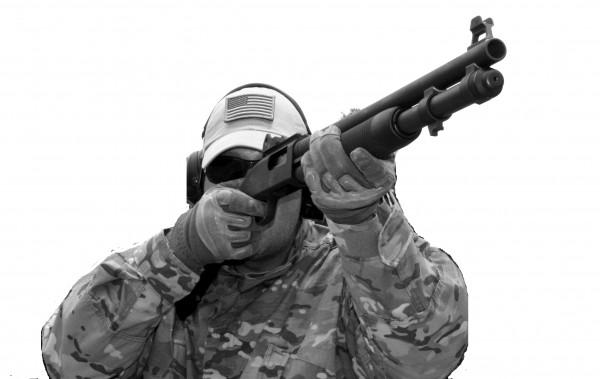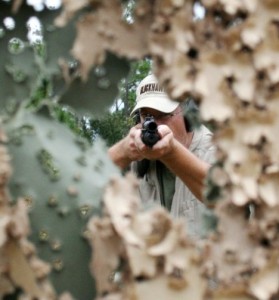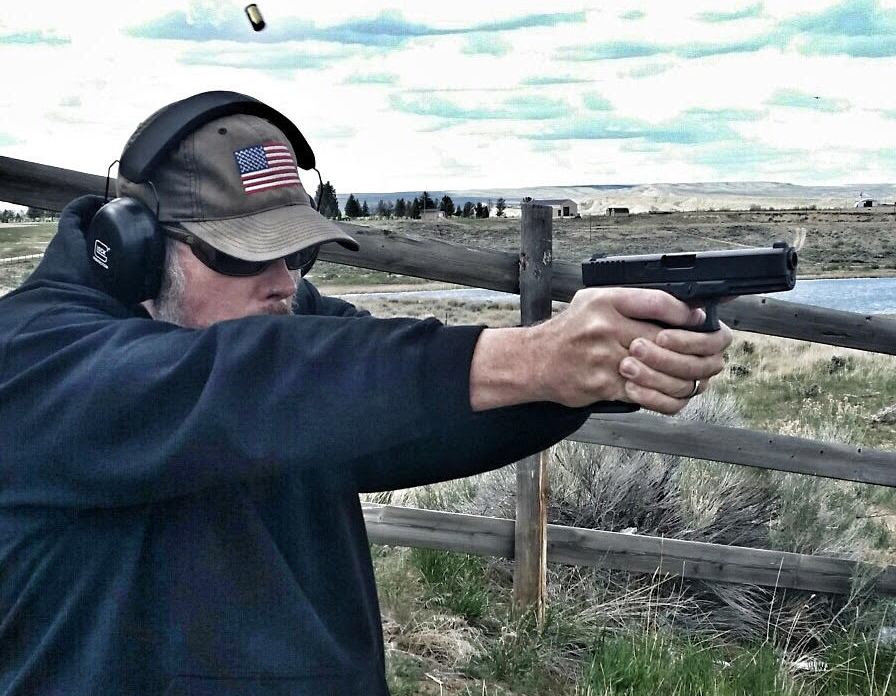Navigate This Post

The shotgun is a tremendous fighting tool surrounded by mythology.
You don’t need a doctorate in history to realize that the saga of human conflict is cyclical. Consider the history of modern warfare. One of the most noteworthy instances of the shotgun’s use in combat came from WWI and the infamous Winchester “Trench Guns”. Every true gun guy knows the story of the feared shotguns and how the Germans were reportedly ‘terrorized’ by the use of scatterguns by U.S. Marines in close combat.
WWII
World War II was a slightly different story, with semi-automatic Garand rifles and Thompson submachine guns being the battlefield norm. Everyone remembers images of Marines clearing the jungles of Japanese held islands with the Thompson guns in hand or the GI bounding a hedgerow in Normandy with his Garand.
Check out our Official Student of the Gun Apparel!
Although not glorified in the popular press, Vietnam combat veterans will tell you that the pump-action 12 gauge shotgun definitely left its mark during that particular conflict. I personally had one ‘Nam Vet relate to me that of all the sounds of combat when he heard the distinctive blast of a shotgun he knew someone just got messed up. Today we are yet again embroiled in a conflict between good and evil. And gain the 12 gauge shotgun is carving out a niche for itself. A good friend of mine is a Marine Corps veteran of the April 2004 Battle of Fallujah. This man was a Machinegun Section Leader and his personal weapon during that fight was a 12 gauge shotgun. (A Section Leader oversees teams of Marines armed with the M240B 7.62mm machineguns.) My friend and I discussed the use of a shotgun in an urban combat environment at length. He enthusiastically endorsed the 12 gauge shotgun for the kind of “in your face” fighting they were conducting.
The Combat Shotgun
Before we get into gun specifics, I feel it is important to ponder just why it is that we should consider discussing the shotgun in the first place. After, there are numerous handguns and carbines available. My previously mentioned comrade and I were members of a training team and we worked with military personnel on a daily basis. Of the small arms we taught, the shotgun was one of them. Our student base could vary greatly from little to no experience to those who had a good deal of hands-on with a shotgun. Despite the experience or lack thereof, I found that we are still running into some of the same old shotgun myths that have perpetuated for generations. I cannot, in good conscience, proceed without addressing a few of the more prevalent ones head on.
Myth #1
“The shotgun is so powerful it can dislocate your shoulder, especially with ‘magnum’ loads.” or some variation thereof. Unless you were previously injured, infirm, or cursed with abnormally brittle bones, the shotgun is not going a break your collarbone, dislocate your shoulder, or break your wrist. (Yes, one young trooper had been told that very thing.) Apply some simple manufacturer’s liability logic to this myth. If XYZ Company’s shotguns were dislocating people’s shoulders, do you not think that would represent a liability problem? Yes, if you try to hold the stock just off of your shoulder like many uneducated people will do, it will kick back and sting you. As a result, you get a bruise, not a broken collarbone. And yes, fifty to one-hundred rounds of 00 buck fired in a single session can leave you sore, but so does football practice, jujitsu, or any other physical sport if you exert yourself.
Myth #2
“As long as you point the gun toward the target you can’t miss.” Or “It’s impossible to miss at close range with a shotgun.” Sure, if you are shooting #9 birdshot from a cylinder-bore barrel the spread at ten, fifteen, twenty yards is going to be very wide. However, we aren’t using birdshot to stop evil men, we will most generally be using 00 buck in the 8 or 9 pellet variety.
I have stood back and watched shooters completely miss a cardboard silhouette target from ten yards with a pump-action 12 gauge and 00 buck. Shotgun or not, you still have to apply basic marksmanship fundamentals. That front sight blade or bead needs to be on the target and stay there until you have pressed the trigger.
Shotgun shooters need pellet spread and patterning education. Using a standard cylinder-bore pump shotgun with an 18 to 20 inch barrel I have found (as have many other instructors) that 00 buck patterns will spread an average of ½ to 1 inch for every yard traveled. Yes, some patterns are tighter, but the ½ to1 inch model is a good benchmark. Translation: At five yards your 00 buck pattern is likely to be five inches or tighter. Yes, you can indeed miss a human with a shotgun.
Myth #3
“Shotguns are used when the target is beyond handgun range.” If you are using a shotgun loaded with slugs and the sights on that gun are zeroed, then yes, you can push your range out much farther. On the other hand, all the military units I have worked with issue 00 buckshot in the 9 pellet variety exclusively.

Downrange view of 12 gauge scattergun.
Let’s refer back to our shot spread average of 1 inch per yard. If you are shooting at a humanoid target with a cross-section of 18 inches and the distance to target is 25 yards, it doesn’t take an MIT graduate to calculate that a percentage of those pellets are going to completely miss your target. The farther away you move, the larger that shot cone becomes.
So, if a shotgun loaded with 00 buck is not a distance weapon, what is it? It is a power weapon or as I like to call it a power tool. According to Winchester’s factory data, their Ranger 00 buck 9 pellet load is traveling an average 1145 FPS out of the muzzle. A 00 buck pellet is .33 caliber and weighs about 54 grains. That’s 486 grains of copper coated lead striking the target simultaneously at better than 1000 feet per second. That, my friends, is where the power comes from.
Closing Thoughts
We have spent some time here considering the combat shotgun. We have even busted some of the more common myths that center on the scatterguns. If you take one thing from this piece it should be that the shotgun is a powerful weapon. Especially for self-defense.
Should you choose a pump-action or semi-automatic? The choice is up to you. Each one has distinct advantages and attributes. The Mossberg 590 is tough and reliable pump-action fighting gun. Conversely, the M4 semi-automatic shotgun from Benelli is so robust that it met the U.S. Marine Corps toughness test.
The primary question you must ask yourself is this: what is your mission and what do you wish to accomplish? In the end the choice is up to you.
JOIN FREE: Click Here for Complimentary Access
Professor Paul Markel
Latest posts by Professor Paul Markel (see all)
- Tactical Rifle Tips: Transition Drills - January 5th, 2024
- 40/20/25 Shooting Drill - October 29th, 2023
- Working With Your Body Armor - October 3rd, 2023
- Hi-Point YC9: Yeet Cannon - August 14th, 2023
- Texas Hog Hunting: Day or Night w/ One Rifle - July 25th, 2023


Close quarter fighting I’d have no problem using double OO. But if I’m shooting at targets further than 25 yards away I’m going to load up with slugs. I keep a Mossberg 590 in the house. First round is #6 bird shot, next five are OO and the last two are slugs. There’s probably a better combination but that’s what I have. I’ve heard that #6 is a good choice because it won’t over penetrate and hopefully end the fight. We all know OO will end the fight but you need to be aware of what’s behind your target. I’ve shot slugs through 3/4 inch plywood at 80 yards so they will easily penetrate your neighbors house so beware.
Great article about reality. My simple rule is to be as far away as possible and as accurate as possible.
In the home a sawed off shotgun with #8 shot is effective in 2 ways. one, it spreads faster and is less damaging to off target unfortunates who get in the way. Two, the report is plenty loud enough to scare people away and yet quieter than the report of a 45 which can easily miss in the dark and cause greater collateral damage. With today’s modern “stick built” construction a pistol or rifle round can pass through walls and into neighbors homes threatening them as well.
Or you can purchase specialty rounds for your hand weapon that include shot, rock salt, wax, rubber, pepper corns, rubber pellets and more. One can use high grade hard wax and pour their own specialty rounds making them as lethal or less lethal as they wish.
I have 6 living in my home and that is plenty to worry about from an errant projectile.
Of course it is all a balancing act now isn’t it?
I do not believe in using a blank first. Nor do I believe in using a kill shot first in the dark. One “accident” can leave a lifetime of pain and heartbreak.
In the day I use a hand gun with standard rounds because I can see the target clearly and can consider the external factors in milliseconds. At night I change magazines and prepare for a different battle.
It is important to note the different type of intruders. Those who come in the day are fully intent on mayhem while doing their dirty work. Most are armed as well. At night most miscreants are looking for an easy mark. In and out avoiding waking up the homeowner.
Either way it is an occupational hazard either takes with death as that hazard.
A home invasion is different, because it is a smash and grab situation, they are not quiet and they are violent with intent to kill anything that gets in the way. If you can hear them loudly then you have to change your mindset and use full intent to kill.
One can model their ammo loading with specialty rounds increasing in lethality. If a third round is necessary then so is intent to kill. one can pop off 3 rounds in about a second. Well practiced shooting will almost eliminate the delay and re acquiring of the target.
This can only come through muscle memory and appropriate practice. I cannot express the importance of range time and movement practice.
I pray that the reader never gets into a situation where it is needed.
4 vehicles in my driveway a home alarm and a dog, as well as no trespassing signs on the fences should be sufficient but criminals are not known for their intelligence now are they? We have had 4 robberies in my yard alone. This in a good “upscale” neighborhood.
Outstanding article once again Paul, I think those who have grown up shooting birds and small game are more distinctive shooters than those who have it stuck in their heads that all they have to do is point and shoot and everything will work out.
Great article and then Some of the worst advice ever in the comments section!
I have a Mossberg 500 loaded with 00, same as law enforcement. In my pistols amd revolvers I apply the same logic. Whatever law enforcement loads, I load. They have the same “over-penetration” vs. Threat-neutralization concerns as do the home owner. I figure if I’m ever called to justify using lethal force, loading the same ammo as law-enforcement speaks to the “reasonable man”.
love it. the shotgun rocks.
give us more 12g wisdom, SOTG!